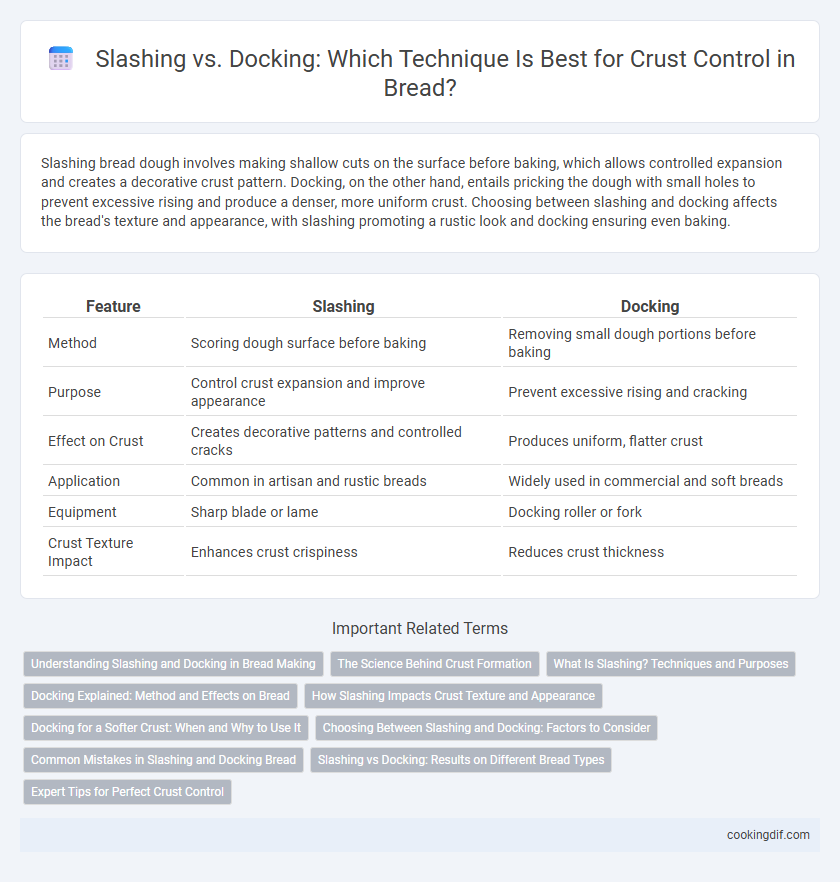Slashing bread dough involves making shallow cuts on the surface before baking, which allows controlled expansion and creates a decorative crust pattern. Docking, on the other hand, entails pricking the dough with small holes to prevent excessive rising and produce a denser, more uniform crust. Choosing between slashing and docking affects the bread's texture and appearance, with slashing promoting a rustic look and docking ensuring even baking.
Table of Comparison
| Feature | Slashing | Docking |
|---|---|---|
| Method | Scoring dough surface before baking | Removing small dough portions before baking |
| Purpose | Control crust expansion and improve appearance | Prevent excessive rising and cracking |
| Effect on Crust | Creates decorative patterns and controlled cracks | Produces uniform, flatter crust |
| Application | Common in artisan and rustic breads | Widely used in commercial and soft breads |
| Equipment | Sharp blade or lame | Docking roller or fork |
| Crust Texture Impact | Enhances crust crispiness | Reduces crust thickness |
Understanding Slashing and Docking in Bread Making
Slashing involves making deliberate cuts on the dough surface before baking to control oven spring and create distinct crust patterns, enhancing both texture and appearance. Docking, on the other hand, uses a tool to puncture the dough uniformly, preventing excessive rising and producing a flatter crust with fewer air pockets. Understanding these techniques allows bakers to manipulate crust development and achieve desired bread aesthetics and texture effectively.
The Science Behind Crust Formation
Slashing creates controlled weak points on the dough's surface, allowing steam to escape and promoting an even crust expansion, which results in a desirable texture and appearance. Docking involves piercing the dough with small holes to prevent excessive rising and reduce large air bubbles, leading to a thinner, crisper crust. Both techniques influence crust formation by managing gas release and heat distribution during baking, directly affecting the Maillard reaction and caramelization processes.
What Is Slashing? Techniques and Purposes
Slashing is a bread scoring technique where shallow cuts are made on the dough surface before baking to control expansion and create decorative patterns. These incisions direct the release of steam, preventing uncontrolled cracking and enhancing crust texture. Proper slashing improves oven spring and contributes to an appealing artisanal appearance in crusty breads like sourdough and baguettes.
Docking Explained: Method and Effects on Bread
Docking involves piercing the dough with a tool before baking to allow steam to escape, preventing uncontrolled crust blistering and uneven rises. This method creates a uniform, flat crust by controlling heat and moisture during baking, essential for certain bread types like flatbreads and sandwich loaves. Proper docking improves texture and appearance, reducing the risk of large air pockets and excessive crust cracks.
How Slashing Impacts Crust Texture and Appearance
Slashing dough before baking creates controlled expansion areas, resulting in a crust with defined ridges and an artisan appearance. This technique influences crust texture by promoting crispness along the cuts while maintaining a tender crumb inside. Unlike docking, which prevents blistering by releasing gas evenly, slashing enhances visual appeal and allows for more complex crust development.
Docking for a Softer Crust: When and Why to Use It
Docking dough involves creating small perforations to prevent excessive crust formation, resulting in a softer, more tender crust optimal for sandwich breads or pastries. This technique controls steam escape and reduces blistering during baking, ensuring a uniform texture without the crunchy exterior typical of slashing. Bakers employ docking specifically when aiming for delicate crusts that complement the bread's softness and interior crumb structure.
Choosing Between Slashing and Docking: Factors to Consider
Choosing between slashing and docking for crust control depends on factors like desired crust texture, oven type, and dough hydration. Slashing creates controlled expansion and artisan-style crusts by allowing steam to escape, while docking prevents large bubbles, resulting in a uniform, crisp crust. Consider dough elasticity, baking temperature, and final bread appearance to optimize crust quality and overall bake performance.
Common Mistakes in Slashing and Docking Bread
Common mistakes in slashing bread include cutting too shallow or too deep, resulting in uneven expansion or bursting crusts, which affects the final texture and appearance. Docking errors often stem from over-docking, creating excessive holes that cause dryness and loss of volume during baking. Proper control of incision depth and docking frequency is essential for optimal crust formation and oven spring in artisanal bread.
Slashing vs Docking: Results on Different Bread Types
Slashing creates controlled expansion points on the bread crust, enhancing both appearance and texture by allowing steam to escape during baking, which is particularly effective on artisan loaves like sourdough and baguettes. Docking involves puncturing the dough surface to prevent excessive rising and is commonly used for softer breads and pizza dough to achieve a uniform and flat crust. Different bread types respond uniquely; slashing promotes open crumb and crisp crust in rustic breads, while docking ensures even baking and smooth crust on enriched or flatbreads.
Expert Tips for Perfect Crust Control
Slashing bread dough allows steam to escape, creating controlled expansion and a visually appealing crust pattern while preventing unpredictable cracking. Docking involves piercing the dough with a tool to release air bubbles, resulting in a thinner, more uniform crust ideal for flatbreads and pizza bases. Expert bakers recommend choosing slashing for artisan loaves to enhance crust texture and docking for doughs needing consistent thickness and reduced bubbling.
Slashing vs Docking for crust control Infographic

 cookingdif.com
cookingdif.com